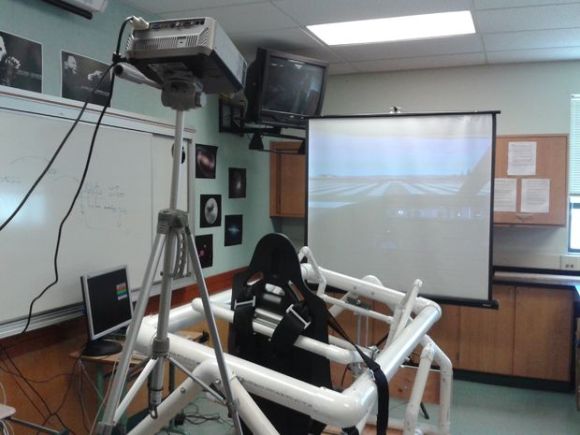
Remember that feature a few days ago about the Cessna 172 flight simulator? It was pretty awesome. But do you know what it was missing? It was missing this. A fully motion-controlled, pneumatically driven, flight simulator cockpit.
[Dominick Lee] is a high school senior, and he was able to whip together this awesome flight simulator made out of PVC pipe, pneumatic cylinders, an Arduino, a projector, and a gaming PC — in just a few months time! He calls it the LifeBeam Flight Simulator, and he’s released all the information required to make one yourself.
It’s most similar to a Stewart platform simulator, which features 2 degrees of freedom, but instead of 6 actuators, this one runs on only two pneumatic cylinders. It works by exporting the roll and pitch (X and Y) data from the game, and then parsing it to an Arduino which controls the pneumatic valve amplifier, powering the cylinders.
It’s an amazing project, and it sounds like [Dominick] had an awesome physics professor, [Dr. Bert Pinsky], to help mentor him. Don’t forget to check out the demonstration video!
[Thanks Matt!]
















In case anyone is unfamiliar – this looks really similar to the JoyRider PVC flight simulator:
http://www.acesim.com/chapter2.html
http://home.comcast.net/~srdots/my_flight_simulator.htm
Pretty cool that a high-schooler built it; the addition of pneumatic actuators probably increases the realism (the JoyRider was a “manual” platform); that said, even in the JoyRider days (late 1990s?) people were making custom pneumatic motion platforms as well.
You can’t say “cockpit” without saying “cock”.
Now just combine it with an Oculus rift and you’ve got a hell of an arcade ride!
While this is a great hack, and I’m glad that this senior is spending their time constructively, the pitch and roll of the aircraft have almost no bearing on the feeling of pitch and roll while sitting in a room. A better metric to control the roll of the sim would be whether the aircraft is in coordinated flight. Essentially, the roll of the sim should be the same as the deflection of the “ball” in the turn coordinator. Also, the pitch should be used to simulate acceleration/deceleration. The most dramatic feedback, other than sight, sound and smell, is “normal” acceleration, or ‘G’s. These are the forces that you feel in turns and when making abrupt changes it flight attitude. Unfortunately, they’re also the most expensive to reproduce.
Now, that’s a hack! Looks like the screen should be mounted on the pilot’s frame so it moves with him.
Not even remotely related to a stewart platform. This is a gimbal, plain and simple.
It is certainly a gimbal and is very clever since the actuators do not have to support the entire weight of the operators rather than compensate for the motion.
Logitech ATK3. I’d recognize that joystick anywhere.
Stewart platforms have 6dof and six actuators in a specific arangement – thats what makes them stewart platforms. You cannot do anything similar with only two actuators.
It doesn’t seem to match the visuals on the screen even a little. It seems like it’s tied to the controller and not what the plane on the screen is doing, or am I crazy?
I noticed that too.
Well, that is what the article says.
Ooohhh! I love these PVC motion simulators. Been considering building one but I’m waiting for the Oculus Rift before I consider it. :) Looks like a good build here. These are a few years old now, at least. I saw on using windshield wiper blades back in the day. So badass.
http://www.youtube.com/watch?v=HJoi-1g0IzI
Pneumatics are a really poor choice for this – because they’re air powered, they “bounce” due to the compressability(sp) of the air in the cylinder.
A 2-axis system is good enough for very basic motion-onset cues, but because the video system isn’t riding with the motion platform, there’s really no point to it.
Check out http://www.builtforfun.co.uk to see an excellent example of 2 and 3 axis DIY motion rigs. He also supplies software that will get the motion-onset cues right.
For a more realistic experience, it will need to “auger in”, as that is what happens whenever I played with a flight sim.